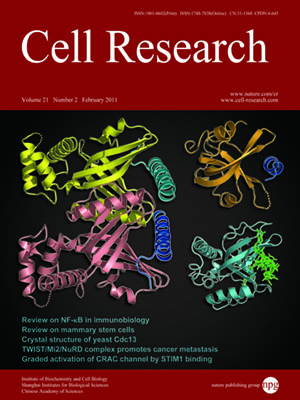
Volume 21, No 2, Feb 2011
ISSN: 1001-0602
EISSN: 1748-7838 2018
impact factor 17.848*
(Clarivate Analytics, 2019)
Volume 21 Issue 2, February 2011: 305-315
ORIGINAL ARTICLES
Graded activation of CRAC channel by binding of different numbers of STIM1 to Orai1 subunits
Zhengzheng Li1,*, Lin Liu2,*, Yongqiang Deng1,*, Wei Ji1, Wen Du1, Pingyong Xu1, Liangyi Chen1 and Tao Xu1,2
1National Key Laboratory of Biomacromolecules, Institute of Biophysics, Chinese Academy of Sciences, Beijing 100101, China;
2College of Life Science and Technology, Huazhong University of Science and Technology, Wuhan 430074, China
Correspondence: Tao Xu, Liangyi Chen,(xutao@ibp.ac.cn; chen_liangyi@yahoo.com)
The Ca
2+ release-activated Ca
2+ (CRAC) channel pore is formed by Orai1 and gated by STIM1 after intracellular Ca
2+ store depletion. To resolve how many STIM1 molecules are required to open a CRAC channel, we fused different numbers of Orai1 subunits with functional two-tandem cytoplasmic domains of STIM1 (residues 336-485, designated as S domain). Whole-cell patch clamp recordings of these chimeric molecules revealed that CRAC current reached maximum at a stoichiometry of four Orai1 and eight S domains. Further experiments indicate that two-tandem S domains specifically interact with the C-terminus of one Orai1 subunit, and CRAC current can be gradually increased as more Orai1 subunits can interact with S domains or STIM1 proteins. Our data suggest that maximal opening of one CRAC channel requires eight STIM1 molecules, and support a model that the CRAC channel activation is not in an “all-or-none” fashion but undergoes a graded process via binding of different numbers of STIM1.
The Ca2+ release-activated Ca2+ (CRAC) channel pore is formed by Orai1 and gated by STIM1 after intracellular Ca2+ store depletion. To resolve how many STIM1 molecules are required to open a CRAC channel, we fused differen
FULL TEXT | PDF
Browse 2124


